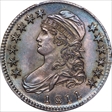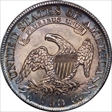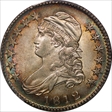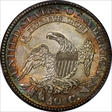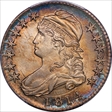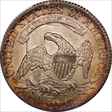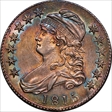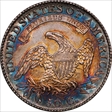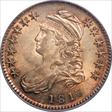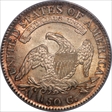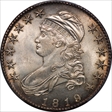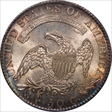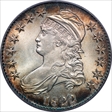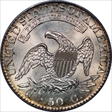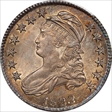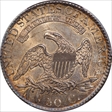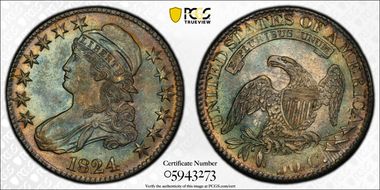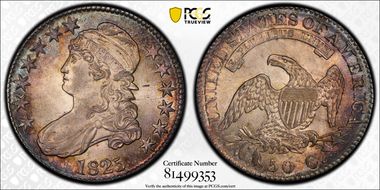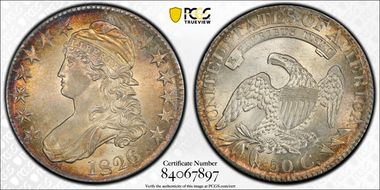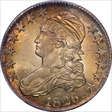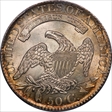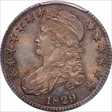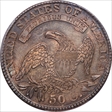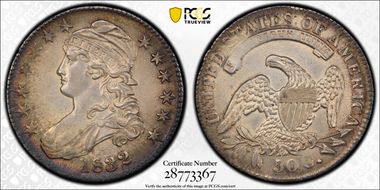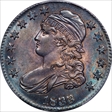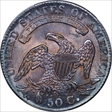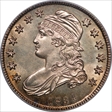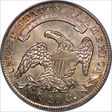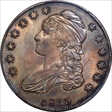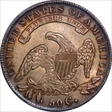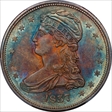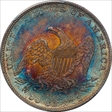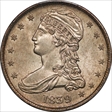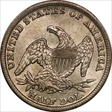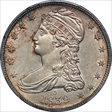Keigwin's Basic Set '94 on 的钱币相册
O.112, R1. CAC. The misnamed 50/20 variety...the 2 underneath the 5 in the denomination is really just an upside down 5! The example has lovely album toning with blue and gold rims and orange and grey centers. Nicely struck with pleasant surfaces and no distractions.
O.112, R1. CAC. The misnamed 50/20 variety...the 2 underneath the 5 in the denomination is really just an upside down 5! The example has lovely album toning with blue and gold rims and orange and grey centers. Nicely struck with pleasant surfaces and no distractions.
O.102a, R1. This variety is notable, and was collected for its different edge lettering. For reasons we can only guess, four of 1809's 15 varieties have XXX characters stamped into the edge. Four other varieties used III inscriptions. (One variety, the O.108 shows both.) A good guess is that this was done to repair flawed die bars but no one really knows. According to Ivan Leaman and Donald Gunnet's 1986 report, Edges and Die Sequences on Early Half Dollars... ...three of the 1809 edges bear ornamentation and are called the experimental edges. The third edge exhibits heavy vertical grooves at the beginning of each bar in front of FIFTY and HALF. The fourth edge is called the engrailed edge. There is a series of X-like figures at the front of the first bar and at the end of the second. The sixth edge contains only 106. There are light grooves in the front of HALF. We call this the pseudo-engrailed edge.
O.102a, R1. This variety is notable, and was collected for its different edge lettering. For reasons we can only guess, four of 1809's 15 varieties have XXX characters stamped into the edge. Four other varieties used III inscriptions. (One variety, the O.108 shows both.) A good guess is that this was done to repair flawed die bars but no one really knows. According to Ivan Leaman and Donald Gunnet's 1986 report, Edges and Die Sequences on Early Half Dollars... ...three of the 1809 edges bear ornamentation and are called the experimental edges. The third edge exhibits heavy vertical grooves at the beginning of each bar in front of FIFTY and HALF. The fourth edge is called the engrailed edge. There is a series of X-like figures at the front of the first bar and at the end of the second. The sixth edge contains only 106. There are light grooves in the front of HALF. We call this the pseudo-engrailed edge.
O.106, R3. Flashy yellow/white, from a dip no doubt, but a proper one that did not impair luster on the frosty surfaces. The unclashed obverse has crisp details and an early die state, while the well impressed reverse shows some signs of clashing. The coin was struck off-center (note the reeding at 6 and 12 o'clock, both sides). Was NGC cert# 3474530-001.
O.106, R3. Flashy yellow/white, from a dip no doubt, but a proper one that did not impair luster on the frosty surfaces. The unclashed obverse has crisp details and an early die state, while the well impressed reverse shows some signs of clashing. The coin was struck off-center (note the reeding at 6 and 12 o'clock, both sides). Was NGC cert# 3474530-001.
O.109, R3. LDS and probably equivalent to O.109a R5, the so-called single leaf. Through either excessive die wear or die lapping, as evidenced here, the 2nd leaf has been lost. On high grade specimens like this a trace of the 2nd leaf often shows.
O.109, R3. LDS and probably equivalent to O.109a R5, the so-called single leaf. Through either excessive die wear or die lapping, as evidenced here, the 2nd leaf has been lost. On high grade specimens like this a trace of the 2nd leaf often shows.
O.109, R3. LDS and probably equivalent to O.109a R5, the so-called single leaf. Through either excessive die wear or die lapping, as evidenced here, the 2nd leaf has been lost. On high grade specimens like this a trace of the 2nd leaf often shows.
O.101, R2. CAC. From the George Hamilton collection, lot 4093. Originally housed in an NGC old fattie graded AU55 with a CAC gold sticker. The catalog description: It is challenging to find an 1815/2 half dollar with any degree of eye appeal. They are by and large a dull lot, and many of the surviving pieces are impaired in one way or another. The present coin is a wonderful exception. Originally toned in attractive blue, violet, and tangerine-gold toning, both sides are brightly lustrous and sharply struck. Aside from the inevitable die clashing, there are no marks of consequence. Housed in an early generation NGC holder from about 25 years ago (with hologram but without the barcode), this Choice About Uncirculated coin carries the CAC gold sticker indicating it is undergraded by at least one level. An interesting bit of trivia about the 1815/2 is that the entire lot of coins struck in early Jan 1816 were paid out to a single customer: Jones, Firth and Co. How often can we trace provenance and know with certainty the original owner?
O.101, R2. CAC. From the George Hamilton collection, lot 4093. Originally housed in an NGC old fattie graded AU55 with a CAC gold sticker. The catalog description: It is challenging to find an 1815/2 half dollar with any degree of eye appeal. They are by and large a dull lot, and many of the surviving pieces are impaired in one way or another. The present coin is a wonderful exception. Originally toned in attractive blue, violet, and tangerine-gold toning, both sides are brightly lustrous and sharply struck. Aside from the inevitable die clashing, there are no marks of consequence. Housed in an early generation NGC holder from about 25 years ago (with hologram but without the barcode), this Choice About Uncirculated coin carries the CAC gold sticker indicating it is undergraded by at least one level. An interesting bit of trivia about the 1815/2 is that the entire lot of coins struck in early Jan 1816 were paid out to a single customer: Jones, Firth and Co. How often can we trace provenance and know with certainty the original owner?
O.101, R2. CAC. From the George Hamilton collection, lot 4093. Originally housed in an NGC old fattie graded AU55 with a CAC gold sticker. The catalog description: It is challenging to find an 1815/2 half dollar with any degree of eye appeal. They are by and large a dull lot, and many of the surviving pieces are impaired in one way or another. The present coin is a wonderful exception. Originally toned in attractive blue, violet, and tangerine-gold toning, both sides are brightly lustrous and sharply struck. Aside from the inevitable die clashing, there are no marks of consequence. Housed in an early generation NGC holder from about 25 years ago (with hologram but without the barcode), this Choice About Uncirculated coin carries the CAC gold sticker indicating it is undergraded by at least one level. An interesting bit of trivia about the 1815/2 is that the entire lot of coins struck in early Jan 1816 were paid out to a single customer: Jones, Firth and Co. How often can we trace provenance and know with certainty the original owner?
O.101, R2. CAC. From the George Hamilton collection, lot 4093. Originally housed in an NGC old fattie graded AU55 with a CAC gold sticker. The catalog description: It is challenging to find an 1815/2 half dollar with any degree of eye appeal. They are by and large a dull lot, and many of the surviving pieces are impaired in one way or another. The present coin is a wonderful exception. Originally toned in attractive blue, violet, and tangerine-gold toning, both sides are brightly lustrous and sharply struck. Aside from the inevitable die clashing, there are no marks of consequence. Housed in an early generation NGC holder from about 25 years ago (with hologram but without the barcode), this Choice About Uncirculated coin carries the CAC gold sticker indicating it is undergraded by at least one level. An interesting bit of trivia about the 1815/2 is that the entire lot of coins struck in early Jan 1816 were paid out to a single customer: Jones, Firth and Co. How often can we trace provenance and know with certainty the original owner?
O.113a, R4. OGH Cataloger's description: An intensely lustrous example with a ring of pastel rose and copper toning that floats through the stars and legend. Die breaks pass through and over the date. The surfaces are free of blemishes save for a short hairline at the tip of star 4. This is an eye-catching coin! From the Davignon Collection, acquired at Stack’s-Bowers’ Nov. 2012 Baltimore sale, lot 1676.
O.113a, R4. OGH Cataloger's description: An intensely lustrous example with a ring of pastel rose and copper toning that floats through the stars and legend. Die breaks pass through and over the date. The surfaces are free of blemishes save for a short hairline at the tip of star 4. This is an eye-catching coin! From the Davignon Collection, acquired at Stack’s-Bowers’ Nov. 2012 Baltimore sale, lot 1676.
O.101a, R1. The large 8 overdate is represented by two die marriages sharing the same obverse WD. O.101 and O.103. The underlying 7 show its ears at the top and the bar connecting them are clearly visible. Often part of the leg of the 7 appears in the loops below. A nice, clear overdate. The large 8 variety is scarcer than the small 8, with the O.103 being very scarce at the XF grade. This example possesses dazzling luster and vivid, colorful toning.
O.101a, R1. The large 8 overdate is represented by two die marriages sharing the same obverse WD. O.101 and O.103. The underlying 7 show its ears at the top and the bar connecting them are clearly visible. Often part of the leg of the 7 appears in the loops below. A nice, clear overdate. The large 8 variety is scarcer than the small 8, with the O.103 being very scarce at the XF grade. This example possesses dazzling luster and vivid, colorful toning.
O.101a, R1. The large 8 overdate is represented by two die marriages sharing the same obverse WD. O.101 and O.103. The underlying 7 show its ears at the top and the bar connecting them are clearly visible. Often part of the leg of the 7 appears in the loops below. A nice, clear overdate. The large 8 variety is scarcer than the small 8, with the O.103 being very scarce at the XF grade. This example possesses dazzling luster and vivid, colorful toning.
O.115, R3. During 1819 the Mint struck a respectable 2.2 million half dollars using fifteen different die marriages. Five were overdates and ten, yeardates.
O.115, R3. During 1819 the Mint struck a respectable 2.2 million half dollars using fifteen different die marriages. Five were overdates and ten, yeardates.
O.108 R2. This is a very special variety from the Roger Solomon collection. It is a Class IV doubled die (offset hub doubling from centers misaligned). Not shelf doubling...true hub doubling. The reverse WD was slightly offset during its second hub impression, leaving visible doubling on the left wing, talons, claws, leaves, berries and arrow heads. Lovely sunburst rim toning is seen over flashy, clean surfaces, along with bountiful luster on an EDS, full denticles. An exceptional AU58.
O.108 R2. This is a very special variety from the Roger Solomon collection. It is a Class IV doubled die (offset hub doubling from centers misaligned). Not shelf doubling...true hub doubling. The reverse WD was slightly offset during its second hub impression, leaving visible doubling on the left wing, talons, claws, leaves, berries and arrow heads. Lovely sunburst rim toning is seen over flashy, clean surfaces, along with bountiful luster on an EDS, full denticles. An exceptional AU58.
O.104a, R1. 1821 was marked by a small mintage (1.3 million pieces), likely smaller still as many were undoubtedly 1820's struck early in the year. Just 7 marriages resulted with no remarkable varieties. Most are well struck, as is this EDS example. When weak it was in predictable areas...center obverse, eagle's left wing, and banner. Experts believe the 1821 to be an undervalued sleeper and very scarce at AU55 and above. This example has a favorite look: soft rose, gold and amber with rims of blue, green and yellow. Undoubtedly from many years in album storage.
O.104a, R1. 1821 was marked by a small mintage (1.3 million pieces), likely smaller still as many were undoubtedly 1820's struck early in the year. Just 7 marriages resulted with no remarkable varieties. Most are well struck, as is this EDS example. When weak it was in predictable areas...center obverse, eagle's left wing, and banner. Experts believe the 1821 to be an undervalued sleeper and very scarce at AU55 and above. This example has a favorite look: soft rose, gold and amber with rims of blue, green and yellow. Undoubtedly from many years in album storage.
O.113, R3. NTS: regrade Cataloger's description: From the Davignon collection, found on the bourse floor during the 2003 ANA Convention. A blast of vibrant luster greets the eye. Frosty, untoned centers are framed with halos of russet toning. There is not a hint of friction on the devices; contact marks are virtually non-existent. The strike is first rate. In short, an ideal coin for an ambitious type or date collector. This was the last coin consigned to the sale. Keith uncovered and purchased an ethereal `22-113 at the recent Baltimore show. He explained, “[It] did indeed turn out to be a [George] Plimpton [family] Hoard coin. It was lot 700 in the 1981 NASCA sale of the Providence Collection, one of the 3 confirmed Plimpton Hoard auctions. I was able to identify it with 100% certainty from position of minor toning spots in the catalog photos.” Keith’s sleuthing and good fortune shook loose the coin offered here.
O.113, R3. NTS: regrade Cataloger's description: From the Davignon collection, found on the bourse floor during the 2003 ANA Convention. A blast of vibrant luster greets the eye. Frosty, untoned centers are framed with halos of russet toning. There is not a hint of friction on the devices; contact marks are virtually non-existent. The strike is first rate. In short, an ideal coin for an ambitious type or date collector. This was the last coin consigned to the sale. Keith uncovered and purchased an ethereal `22-113 at the recent Baltimore show. He explained, “[It] did indeed turn out to be a [George] Plimpton [family] Hoard coin. It was lot 700 in the 1981 NASCA sale of the Providence Collection, one of the 3 confirmed Plimpton Hoard auctions. I was able to identify it with 100% certainty from position of minor toning spots in the catalog photos.” Keith’s sleuthing and good fortune shook loose the coin offered here.
O.101a, R1. At some point Mint officials chose to touch up the WD that had been producing broken 3 varieties. The results would turn out less than graceful. The softened die was struck with a short blunt punch to impart a connection to the separated 3 pieces and the patched 3 was born. The die was placed back in service (O.101a) and later mated to a new reverse (O.102), giving us two die marriages. This example is one of the prettiest I have come across with its rose and amber central toning and blue rims with a touch of brick red. Full luster and clean surfaces give it strikingly strong eye appeal.
O.101a, R1. At some point Mint officials chose to touch up the WD that had been producing broken 3 varieties. The results would turn out less than graceful. The softened die was struck with a short blunt punch to impart a connection to the separated 3 pieces and the patched 3 was born. The die was placed back in service (O.101a) and later mated to a new reverse (O.102), giving us two die marriages. This example is one of the prettiest I have come across with its rose and amber central toning and blue rims with a touch of brick red. Full luster and clean surfaces give it strikingly strong eye appeal.
O.117, R1. Ex-Davignon. Catalog description: Another magnificent 1824. This example features electric sea-green toning in the centers, with a halo of pale gold through the stars and legend. Minor striking weaknesses in the lowest drapery lines and a portion of the motto are trifling criticisms. Picked up at the Nov. 2007 Baltimore Show.
O.117, R1. Ex-Davignon. Catalog description: Another magnificent 1824. This example features electric sea-green toning in the centers, with a halo of pale gold through the stars and legend. Minor striking weaknesses in the lowest drapery lines and a portion of the motto are trifling criticisms. Picked up at the Nov. 2007 Baltimore Show.
O.117, R1. Ex-Davignon. Catalog description: Another magnificent 1824. This example features electric sea-green toning in the centers, with a halo of pale gold through the stars and legend. Minor striking weaknesses in the lowest drapery lines and a portion of the motto are trifling criticisms. Picked up at the Nov. 2007 Baltimore Show.
O.105', R1. CAC. MB43 catalog description: This is a scrumptious MS63! Intense luster dances beneath the pastel gold toning. Very early die state, scarce as such. The central devices are razor sharp. Only stars 8 and 9 lack center points. All in all, a regal coin looking for a home in an important collection. ex-Link. Was NGC MS64 3164052-001
O.105', R1. CAC. MB43 catalog description: This is a scrumptious MS63! Intense luster dances beneath the pastel gold toning. Very early die state, scarce as such. The central devices are razor sharp. Only stars 8 and 9 lack center points. All in all, a regal coin looking for a home in an important collection. ex-Link. Was NGC MS64 3164052-001
O.109, R3. NTS: regrade Catalog description: Exquisite surfaces and a razor sharp strike justify the near gem designation. Light toning circles the stars and legend. The centers burst with unfettered luster. Look carefully at Liberty’s curls and drapery lines; then inspect the full, rounded feathers and claws of the eagle. If you demand the very best you’re on the right trail. From the collection of Dr. Charles Link.
O.109, R3. NTS: regrade Catalog description: Exquisite surfaces and a razor sharp strike justify the near gem designation. Light toning circles the stars and legend. The centers burst with unfettered luster. Look carefully at Liberty’s curls and drapery lines; then inspect the full, rounded feathers and claws of the eagle. If you demand the very best you’re on the right trail. From the collection of Dr. Charles Link.
O.114, R2. 1836 was a year of change for the Mint. At the most fundamental level screw presses were replaced with steam driven ones. For the bust half, edge lettering dies would be retired and closed collars introduced which produced reeded edges. A new design was crafted by Gobrecht, who was able to hub design elements, removing the laborious punching effort that produced so many lettered-edge varieties. It was a transitional year for the Mint and the half dollar, though. And the screw press produced, open collar stamped, working die punched, capped bust half dollar went out with a blaze of variety glory. Some of the popular ones include the 1836/1336, 50/00, bar dot, doubled clasp, beaded edge. We even got a small production of reeded-edge 1836 halves. This example is a very lustrous, handsomely toned AU58...one of the last lettered edge halves of its era.
O.114, R2. 1836 was a year of change for the Mint. At the most fundamental level screw presses were replaced with steam driven ones. For the bust half, edge lettering dies would be retired and closed collars introduced which produced reeded edges. A new design was crafted by Gobrecht, who was able to hub design elements, removing the laborious punching effort that produced so many lettered-edge varieties. It was a transitional year for the Mint and the half dollar, though. And the screw press produced, open collar stamped, working die punched, capped bust half dollar went out with a blaze of variety glory. Some of the popular ones include the 1836/1336, 50/00, bar dot, doubled clasp, beaded edge. We even got a small production of reeded-edge 1836 halves. This example is a very lustrous, handsomely toned AU58...one of the last lettered edge halves of its era.
GR-17 (JR-20), R1. One of the more common varieties and easily available. The obverse is normally well struck but the reverse, even in EDS, shows a significant die crack from 6 o'clock to 11. The reverse die in this example is counter clockwise rotated about 30 degrees. The half has remarkable, vivid toning emphasizing sea blue and green, soft magenta, and fiery orange.
GR-17 (JR-20), R1. One of the more common varieties and easily available. The obverse is normally well struck but the reverse, even in EDS, shows a significant die crack from 6 o'clock to 11. The reverse die in this example is counter clockwise rotated about 30 degrees. The half has remarkable, vivid toning emphasizing sea blue and green, soft magenta, and fiery orange.
GR-5, R2. A frosty, lustrous example of the last year in the series. Untoned and likely carefully dipped. Exceptional reverse strike and a weaker obverse. Some typical planchet roller marks but most subtle. (Was PCGS MS61, cert# 32919580)
GR-5, R2. A frosty, lustrous example of the last year in the series. Untoned and likely carefully dipped. Exceptional reverse strike and a weaker obverse. Some typical planchet roller marks but most subtle. (Was PCGS MS61, cert# 32919580)











































